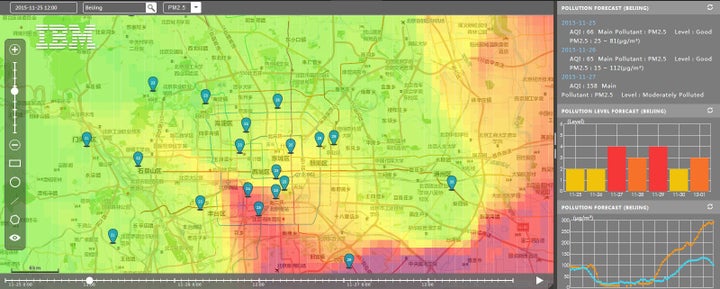For the past year, IBM has been helping Beijing to combat its air pollution crisis using a data analysis platform called Green Horizons. On Wednesday, Big Blue's Research division announced four more partnerships -- two in China, one in India and one in South Africa -- to increase the capacity of more urban centers to measure and monitor air pollution.
When Green Horizons comes to the cities of Baoding, Zhangjiakou, Delhi and Johannesburg, it will use machine learning to analyze previous weather forecasts, crunching data to determine how good those predictions were in different scenarios, and then build better forecasting models over time.
Weather conditions have a direct effect upon how city residents experience the effects of air pollution, from high temperatures increasing ground-level ozone concentrations to high winds carrying industrial particulates into urban areas.

"The system constantly learns how can you improve a forecast, when and where, for what part of the city, and under what time horizon," Hendrik Hamann, manager of physical analytics for IBM Watson, told The Huffington Post.
In the video below, you can see a demonstration of the Green Horizons forecasting system, applying the technology that underpins IBM Watson to predicting the intensity of air pollution:
"Knowing where pollution is coming from and how much is in the air will drive action to reduce it," Bob Perciasepe, president of the Center for Climate and Energy Solutions, told HuffPost. "Experience shows that when measurement happens, pollution levels go down and public health is improved. This near-term action improves the livability of communities and the wellbeing of citizens."
The news of IBM's expanded collaboration comes during the United Nations Climate Change Conference in Paris, where representatives from over 190 countries are discussing an historic accord on reducing greenhouse gas emissions.
"Once we have an agreement, the world will need to know how each country is doing at meeting those commitments," said Perciasepe. "Programs like Green Horizons will help build the capacity for that to happen and in the long term, everyone benefits from that."
Using data analysis to more accurately source, model and mitigate air pollution is a key strategy for combating climate change in urban environments.
While Beijing's ongoing air pollution problems show that these initiatives are no panacea on their own, they can help cities focus and improve their responses. Hamann noted that cities will also have to invest in clean energy generation for the future.
"Power plants and industrial activity are major contributors [of air pollution in Beijing], but even if you take the industrial activity, they are distributed through surroundings," said Hamann. "Take the example of coal plants: A lot are providing backup generation, to pick up peak loads. When you turn on, how much energy do you consume? Given these conditions, what can I do on potentially reducing the energy output of a coal plant?"
IBM Research has developed renewable energy forecasting tools to help cities understand what other power sources they will have -- or need -- to supplement or replace turning on those plants.
"My belief is tech is really the solution to many of those problems, from pollution, to healthy living and a sustainable future," said Hamann. "Through tech like this, we'll cope with the challenge of so many people living in cities. Think about the city of Los Angeles, which was heavily polluted in the 1970s. Through technology, the right policies and catalytic converters, it was completely turned around."
While southern California still has some of the worst air quality in the United States, Los Angeles children are getting healthier, due to improvements in the smog. That outcome was driven by regulations that enforced tougher emissions requirements on vehicles.
Here's hoping that knowing more about the problems drives more cities towards solving them.
